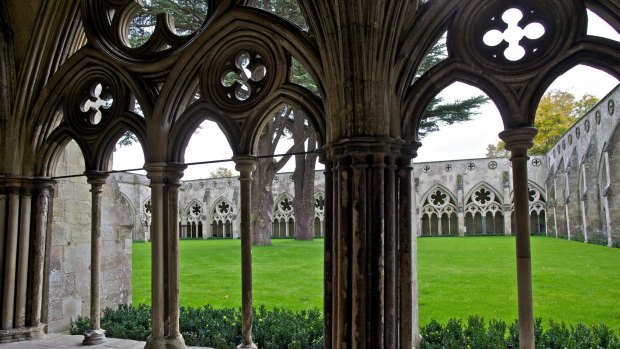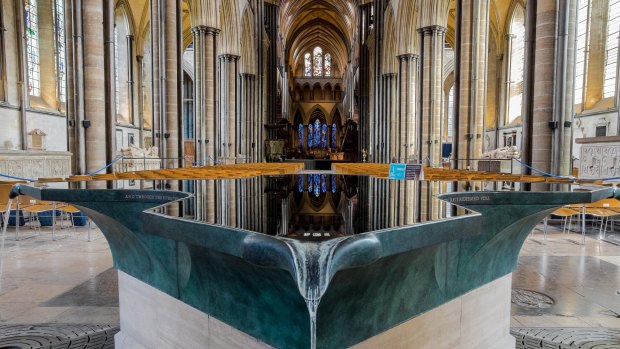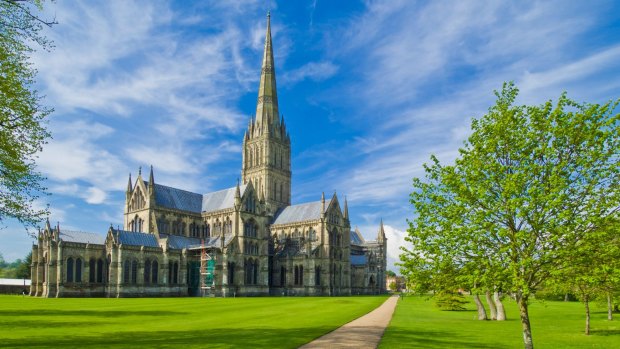This was published 8 years ago
Salisbury Cathedral, England: Where to see the Magna Carta on its 800th birthday
The 800th birthday of the Magna Carta inspires Keith Austin to visit its famous resting place.
By Keith Austin

Home not only to the world's oldest working clock, but also the document that changed history: Inside the grounds of Salisbury Cathedral.Credit: Alamy
Not content with all the superlatives heaped upon it in its history – tallest spire and largest cloister in the UK, keeper of the world's oldest working clock – Salisbury Cathedral trumped them all by consecrating Britain's funkiest font. Designed by British water sculptor William Pye, the groovy three-metre wide, curved cross-shaped bronze vessel is a wonderful mash-up of old and new that makes traditional fonts look like oversized washbasins. Close one eye and squint, and I reckon it's got a touch of the Batman logo about it – for which I shall probably go straight to Hell.
Created for the cathedral's 750th anniversary in 2008, the font's tranquil water (drawn up from beneath the cathedral) reflects and deepens the surrounding architecture while at the corners beautifully turned overflow spouts constantly spill water into bronze gratings in the floor.
It's curiously captivating even for the non-believer. As Pye himself has said: "Not only is the new work a working font, but also something that hopefully will become a major attraction to the 90per cent of visitors entering the cathedral who are not there to worship, but simply as tourists."

The font inside Salisbury Cathedral, designed by William Pye, gives a fantastic reflection of the interior.Credit: Alamy
And if the number of photographers here is anything to go by, it's working – it's hard to get close to it without copping an elbow in the eye.
Salisbury Cathedral was started in 1220 and finished just 38 years later – staggeringly fast for the time. It was built on a large area of marshland unencumbered by nearby dwellings and, as such, the good burghers of Old Sarum were able to surround it, essentially, with … air.
At first glance there's certainly something ethereal about it, despite the 76,500 tons of stone, 2,641 tons of oak and 420 tons of lead that went into its construction. It seems to float on the flat meadowlands around it, as if at any moment it's going to sail Pythonesquely off into the sunset.

Salisbury Cathedral in Wiltshire, England.Credit: Alamy
Or perhaps it's because, like some early Gothic cruise ship, there's so much more above the waterline than below. For a cathedral that sports the tallest spire in the UK, the foundations only go down four feet (1.2 metres).
Or maybe it's the spire itself, all 123 soaring, elegant metres of it, tapering towards the heavens, looking for all the world as if it might lift off and take the main building with it.
All in all, the Cathedral Church of the Blessed Virgin Mary (to give it its official title) is a masterpiece of early medieval architecture, quintessentially English, famously portrayed numerous times by celebrated landscape painter John Constable, and only 12 kilometres from Stonehenge, if you're in the area.
It's also the last resting place of former British Prime Minister Edward Heath and one of the four remaining original copies of the Magna Carta. God only knows where they put Heath but the Magna Carta can be found in the octagonal Chapter House.
Here, in an exhibition space newly renovated for the Magna Carta's 800th birthday and looked down upon by a circular medieval frieze depicting biblical scenes from Genesis and Exodus, sits the best preserved example of the document that established for the first time that everybody, including the king, was subject to the law.
We are taken around the cathedral by one of the volunteers, a smartly dressed chap in a natty sash who knows pretty much everything there is to know about the church and its history. We visit the world's oldest clock and get to stand at the base of one of the supporting stone pillars where, looking up, you can see where it bulged and bent under the weight of the 6500-ton spire after it was finally completed in 1320.
If, after seeing that, you still fancy walking up the 332 narrow spiral staircase steps to the base of the spire, it's best to book ahead as each guided tower tour only takes a maximum of 12 people.
I say "do it" – the views across the countryside are spectacular and you work up a worthy appetite that can be sated in the cathedral's impressive Refectory café afterwards.
TRIP NOTES
MORE INFORMATION
Cathedral tower tours cost £12.50 for adults, £8 for children and £30 for a family (2 adults + 3 children). Advance booking is highly recommended. Visitors may book on arrival but there is no guarantee spaces will be available.
GETTING THERE
All of the major airlines operate frequent flights between Sydney and Melbourne to London, including British Airways, Qantas, Singapore Airlines, Emirates and Cathay Pacific.
Regular inter-city train services from London (Waterloo) to Salisbury take about 90 minutes. For National Rail enquiries in the UK call 08457-484950, or visit www.nationalrail.co.uk for timetable information.
Sign up for the Traveller Deals newsletter
Get exclusive travel deals delivered straight to your inbox. Sign up now.